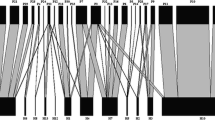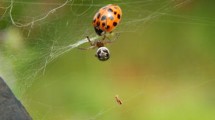Abstract
Species of South American subterranean rodents belonging to the genus Ctenomys (commonly called tuco-tucos) are widely distributed across the southern Neotropical region. Despite their relatively well-studied biology and reproductive physiology, current knowledge of their ectoparasite fauna is limited to a few ambiguous studies, based on scattered samples from a small number of host individuals. Ctenomys talarum is the most widely distributed species in the genus. Lice (Phthiraptera) were collected from these tuco-tucos throughout their entire coastal range. Two species, one chewing louse (Gyropus parvus), and one sucking louse (Eulinognathus americanus) were collected. The distribution ranges for both louse species were extended with new locality records. No lice were found in two host populations. Furthermore, co-occurrence of both ectoparasites was not detected.
Similar content being viewed by others
References
Bidau C.J. 2006. Familia Ctenomyidae. In (Eds R.J. Bárquez, M.M. Díaz and R.A. Ojeda) Mamíferos de Argentina. Sistemática y Distribución. Sociedad Argentina para el Estudio de los Mamiferos Publishing, Buenos Aires, Argentina, 212–231
Bidau C., Dias de Avila-Pires J.F. 2009. On the type locality of Ctenomys bicolor Miranda Riveiro, 1914 (Rodentia: Ctenomyidae). Mastozoología Neotropical, 16, 445–447
Castro D. del C. 1982. Sobre una nueva especie del género Eulinognathus Cummings parásita de Ctenomys brasiliensis Blainville (Anoplura: Polyplacidae). Revista del Museo de La Plata, 131, 25–28
Castro D. del C., Cicchino A.C. 1986. Contribución al conocimiento del género Eulinognathus Cummings, 1916 (Anoplura, Polyplacidae) parásitas de Ctenomyidae (Rodentia, Octodontoidea). Revista Brasileira de Entomología, 30, 375–38
Castro D. del C., Cicchino A.C., Torres-Mura J.C 1987. Estudio descriptivo y comparativo de Gyropus parvus (Mallophaga), parasito de roedores Octodontoideos. Anales del Museo de Historia Natural de Valparaíso 18, 41–45
Cicchino A.C., Castro D. del C. 1994. On Gyropus parvus parvus (Ewing, 1924) and Phtheiropoios rionegrensis sp.n. (Phthiraptera, Amblycera, Gyropidae), parasitic on Ctenomys haigi Thomas, 1919 (Mammalia, Rodentia, Ctenomyidae). lheringia, Série Zoologia 77, 3-14
Cicchino A.C., Castro D. del C. 1998 a. Amblycera. In (Eds J.J. Morrone and S. Coscaron. Biodiversidad de Artrópodos Argentinos — Una Perspectiva Biotaxonómica. SUR, La Plata, Argentina, 84–103
Cicchino A.C., Castro D. del C. 1998 b. Identification of the species of Gyropidae (Phthiraptera, Amblycera) parasitic on the Ctenomyidae (Mammalia, Rodentia) in the Buenos Aires Province, Argentina, on the basis of the external chorionic architecture of the eggs. Revista Brasileira de Entomologia 41, 199–202
Cicchino A.C., Castro D. del C. 1998 c. Phtheiropoios mendocinus sp. nov. y el estado del conocimiento de las demás especies del genero Phtheiropoios Eichler, 1940 (Phthiraptera, Gyropidae) en la provincia de Mendoza, Argentina. Gayana Zoología. 62 (2), 183–190
Cicchino A.C., Castro D. del C., Baldo J.L. 2000. Elenco de los Phthiraptera (Insecta) hallados en distintas poblaciones locales de Ctenomys (Rodentia: Octodontidae) de Argentina, Uruguay, Paraguay y Brasil. Papéis Avulsos de Zoología, 41 (13), 197–211
Contreras J.R., Castro D. del C., Cicchino A.C. 1999. Relaciones de los Phthiraptera (Insecta, Amblycera, Gyropidae) con la evolución taxonómica de los roedores del género Ctenomys (Mammalia: Rodentia, Caviomorpha: Ctenomyidae) Ciencia Siglo XXI, 2, Buenos Aires, Argentina
Ewing H.E. 1923. New genera and species of sucking lice. Journal of the Washington Academy of Sciences, 13 (8), 146–149
Ewing H.E. 1924. On the taxonomy, biology, and distribution of the biting lice of the family Gyropidae. Proceedings of the United States National Museum 63(20), 1–42
Justo E.R., de Santis L.J., Kin M.S. 2003. Ctenomys talarum. Mammalian Species, 730, 1–5
Malizia A.I., Kittlein M.J., Busch C. 2000. Influence of the subterranean rodent Ctenomys talarum (Rodentia: Octodontidae) on vegetation and soil. Zeitschrift für Säugetierkunde, 65, 172–182
Palma R.L. 1978. Slide-mounting of lice: a detailed description of the Canada balsam technique. The New Zealand Entomologist, 6(4), 432–436
Pearson O.P., Binztein L., Boiry L., Busch C., Dipace M., Gallopin G., Penchaszadeh P., Piantanida M. 1968. Estructura social, distribución espacial y composición por edades de una poblacion de tuco-tucos (Ctenomys talarum). Investigaciones Zoológicas Chilenas, 13, 47–80
Rossin M.A, Malizia A.I. 2002. Relationship between helminth parasites and demographic attributes of a population of the subterranean rodent Ctenomys talarum (Rodentia: Octodontidae). Journal of Parasitology, 88, 1268–1270
Rossin M.A., Malizia A.I., Timi J.T., Poulin R. 2010. Parasitism underground: determinants of helminth infections in two species of subterranean rodents Octodontidae). Parasitology, 137, 1569–1575. DOI: 10.1017/S003118201000351
Sikes R.S., Gannon W.L., and the Animal Care and Use Committee of the American Society of Mammalogists. 2011. Guidelines of the American Society of Mammalogists for the use of wild mammals in research. Journal of Mammalogy, 92(1), 235–253. DOI:10.1644/10-MAMM-F-355.1
Author information
Authors and Affiliations
Corresponding author
Rights and permissions
About this article
Cite this article
Martino, N.S., Romero, M.D. & Malizia, A.I. Parasitism underground: lice (Insecta: Phthiraptera) from Ctenomys talarum (Rodentia: Ctenomyidae) along its coastal distribution in Argentina. Acta Parasit. 60, 154–157 (2015). https://doi.org/10.1515/ap-2015-0021
Received:
Revised:
Accepted:
Published:
Issue Date:
DOI: https://doi.org/10.1515/ap-2015-0021




